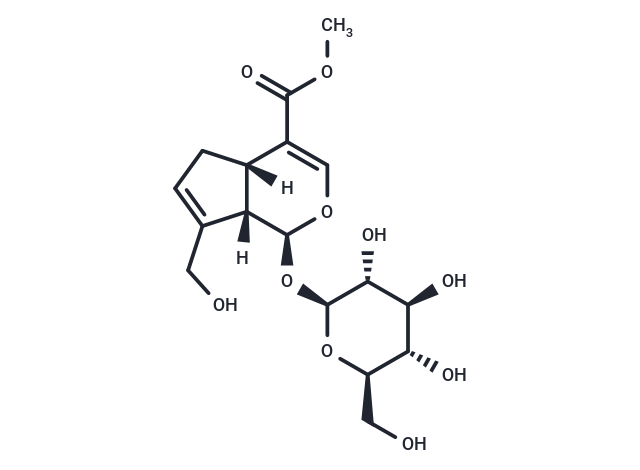Shopping Cart
Remove All Your shopping cart is currently empty
Your shopping cart is currently empty
Geniposide is an iridoid glycoside with a variety of biological activities including neuroprotective, anti-diabetic, antiproliferative, and antioxidative activity. Geniposide has been shown to regulate Nrf2 translocation.

| Pack Size | Price | USA Warehouse | Global Warehouse | Quantity |
|---|---|---|---|---|
| 25 mg | $30 | In Stock | In Stock | |
| 50 mg | $40 | In Stock | In Stock | |
| 100 mg | $60 | In Stock | In Stock | |
| 500 mg | $138 | In Stock | In Stock | |
| 1 g | $197 | In Stock | In Stock | |
| 1 mL x 10 mM (in DMSO) | $44 | In Stock | In Stock |
| Description | Geniposide is an iridoid glycoside with a variety of biological activities including neuroprotective, anti-diabetic, antiproliferative, and antioxidative activity. Geniposide has been shown to regulate Nrf2 translocation. |
| In vitro | Geniposide demonstrates multifaceted bioactivities, including antithrombotic, anti-inflammatory, antidiabetic, anti-atherosclerotic, antidepressant effects, and therapeutic potential for Alzheimer's disease (AD), anti-hypertensive, and toxicological effects, alongside managing adverse reactions[1]. It significantly reduces IL-8, IL-1β, and MCP-1 production in OGD-induced brain microvascular endothelial cells, markedly downregulates P2Y14 receptor expression, and inhibits the phosphorylation of RAF-1, MEK1/2, and ERK1/2[2]. |
| In vivo | Geniposide, administered at doses of 200 and 400 mg/kg, has been observed to significantly reduce blood glucose, insulin, and triglyceride (TG) levels in a dose-dependent manner in diabetic mice. Additionally, it diminishes the expression and enzymatic activity of glucose-6-phosphatase (G6Pase) and glycogen phosphorylase (GP) at both mRNA and protein levels. At dosages of 20.0, 40.0, or 80 mg/kg, geniposide effectively counters the excessive elevation of serum alanine transaminase/aspartate transaminase (ALT/AST) and hepatic lipid peroxidation (LPO) levels induced by alcohol, signifying its potent hepatoprotective properties. Furthermore, it enhances the expression of heme oxygenase-1 (HO-1), mitigating cell apoptosis in primary cultured hippocampal neurons caused by 3-morpholinosydnonimine hydrochloride (SIN-1). In addition to its neuroprotective and hepatoprotective effects, geniposide exhibits anti-thrombotic activity in a photochemistry-induced thromboembolism model in vivo and acts as an effective inhibitor of Nuclear Factor kappa B (NF-κB) activity by preventing IκB degradation. |
| Cell Research | The third passages of brain microvascular endothelial cells (BMECs) are used for the experiment. The BMECs are divided into four groups: (1)normal control group: the normal cultured BMECs without treatment; (2)OGD group: the BMECs injured by OGD according to the above method; (3) geniposide group: the OGD-injured BMECs treated with 33.2 μg/mL geniposide for 6 h; (4)PTX group: the OGD-injured BMECs administrated with 100 ng/mL PTX. PTX, known as an inhibitor of Gi-coupled receptor is used to assess the activation of P2Y14 receptor induced by OGD in this experiment[2]. |
| Molecular Weight | 388.37 |
| Formula | C17H24O10 |
| Cas No. | 24512-63-8 |
| Smiles | O([C@H]1[C@]2([C@@](C(C(OC)=O)=CO1)(CC=C2CO)[H])[H])[C@@H]3O[C@H](CO)[C@@H](O)[C@H](O)[C@H]3O |
| Relative Density. | 1.54g/cm3 |
| Color | White |
| Appearance | Solid |
| Storage | Powder: -20°C for 3 years | In solvent: -80°C for 1 year | Shipping with blue ice/Shipping at ambient temperature. | |||||||||||||||||||||||||||||||||||
| Solubility Information | DMSO: 247.5 mg/mL (637.28 mM), Sonication is recommended. H2O: 40 mg/mL (102.99 mM), Sonication is recommended. | |||||||||||||||||||||||||||||||||||
| In Vivo Formulation | 10% DMSO+40% PEG300+5% Tween 80+45% Saline: 2 mg/mL (5.15 mM), Sonication is recommended. Please add the solvents sequentially, clarifying the solution as much as possible before adding the next one. Dissolve by heating and/or sonication if necessary. Working solution is recommended to be prepared and used immediately. The formulation provided above is for reference purposes only. In vivo formulations may vary and should be modified based on specific experimental conditions. | |||||||||||||||||||||||||||||||||||
Solution Preparation Table | ||||||||||||||||||||||||||||||||||||
H2O/DMSO
| ||||||||||||||||||||||||||||||||||||
| Size | Quantity | Unit Price | Amount | Operation |
|---|

Copyright © 2015-2025 TargetMol Chemicals Inc. All Rights Reserved.